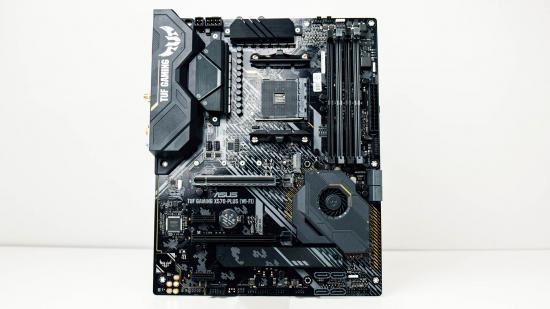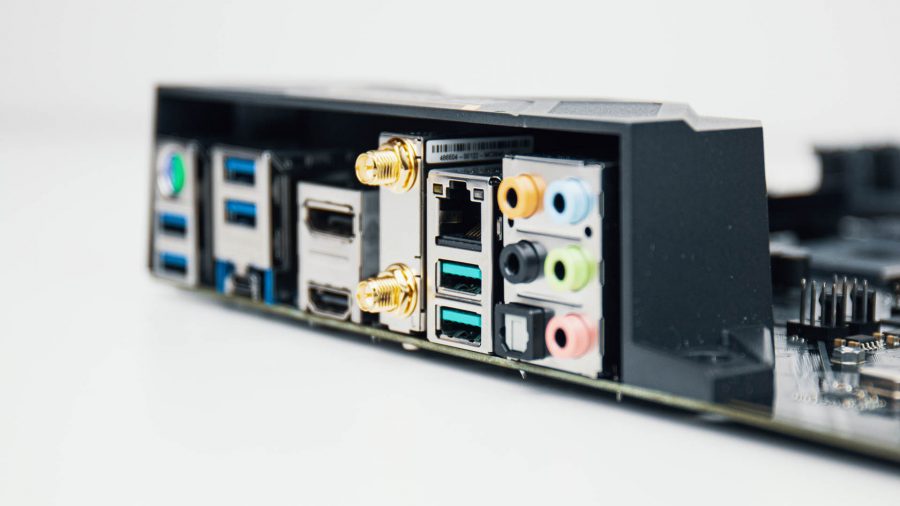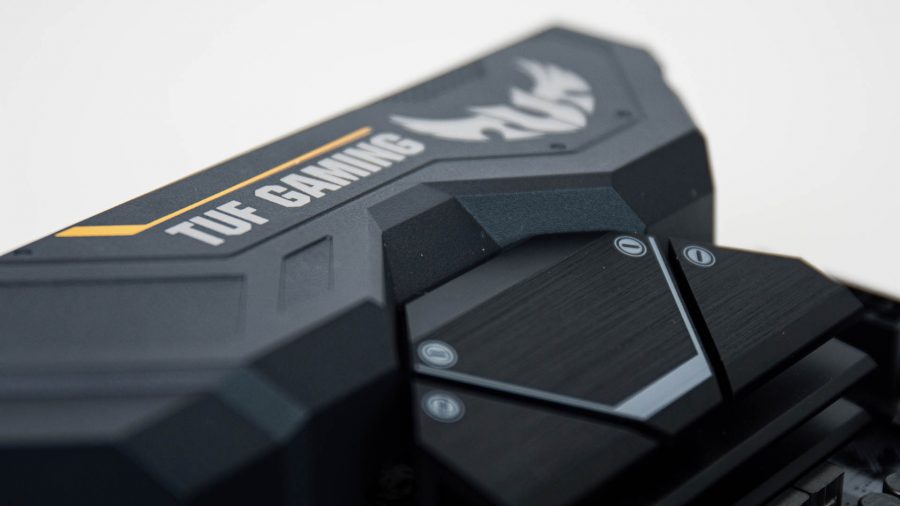Our Verdict
A cheap X570 may be an oxymoron, but Asus' entry-level enthusiast board shrinks the PCIe 4.0 markup into something a little more bite-sized.
- Cheap way to get PCIe 4.0
- Supports Ryzen 5000 out of the box
- Robust and high-value feature set
- Port selection could be better
The Asus TUF Gaming X570-Plus (Wi-Fi) is the cheapest X570 board that we’ve had across out test bench with the initial blitz of motherboards following AMD Ryzen 3000’s launch. Thanks to its pleasing price tag and glimmer of high-end functionality, this X570 represents the most cordial point of entry into the PCIe 4.0 ecosystem.
The X570 chipset has been introduced solely for purveyors of fine, enthusiast-grade motherboards. That is to say, gamers and content creators with fat stacks in the bank. It’s not meant to usurp the X470 or B450 boards in the market, merely sit atop the stack offering a little more to those that want to go all in on Zen 2.
And so that leaves the TUF Gaming in a bit of a pickle. A cheap X570 is an oxymoron. Yet, due to some shifting of key components from the northbridge to the CPU back in the day, any effect a motherboard has on overall system performance has been almost entirely negated. With a very slight delta between the $700 MSI MEG X570 Godlike and the Asus TUF Gaming X570-Plus, the entry-level X570 may just be the best value of the lot.
Because while the TUF series may be the ‘cheap’ option nowadays, Asus hasn’t entirely forgotten what made this range so eccentrically great. The industrial design is carried forward on the budget TUF series boards across two oversized VRM heatsinks, covering six blocks of VRPower SiC639 in triplicate for a total of 12 VCore phases.
The angular chipset fan and I/O aesthetic are somewhat plastic in appearance, however. And I don’t suspect the RGB lighting strip across the bottom right side of the TUF Gaming would’ve been greatly missed.
Sadly, there’s no more of that gorgeous full-body armour plating that used to don boards such as the Sabretooth or Mark S boards. Back in my day…
| ASUS TUF Gaming X570-Plus (Wi-Fi) | |
| Form factor | ATX |
| CPU support | AMD Ryzen 2000, AMD Ryzen 3000 |
| Socket | AM4 |
| Chipset | X570 |
| Memory | 4x DDR4 DIMMs, dual-channel, 4,400MHz+ (OC) |
| Expansion slots | PCIe x16 (2), PCIe x1 (2) |
| Storage | 2x M.2 (PCIe 4.0, x4), 8x SATA 6Gb/s |
| WiFi | Intel Wireless-AC 9290 |
| LAN | Realtek L8200A |
| Audio | 8-Channel High Definition Audio (Realtek ALC S1200A) |
| USB (ext) | 1x USB 3.2 Gen2 Type-A, 3x USB 3.2 Gen2 Type-A, 4x USB 3.2 Gen1 Type-A |
| USB (int) | 2x USB 3.2 Gen1 Type-A, 4x USB 2.0 |
| Price | $200 (£230) |
The TUF Gaming retains PCIe 4.0 bandwidth across two x16 slots and two x1 slots. That’s a little less than what we’ve come to expect with the X570 platform, no doubt due to cost-saving measures. Luckily a pair of M.2 slots capable of utilising the full PCIe 4.0 bandwidth have come out unscathed from the austerity hammer.
That means the Phison PS5016 controller, so far the sole PCIe 4.0 capable SSD on the market, is able to run at full whack. That’s a touch over 4,100MB/s sequential read and a little under 3,900MB/s sequential write in AS SSD.
And while those same cost-saving measures come into effect on the rear I/O, there’s a modicum of USB ports at hand to see you through. In total on the rear I/O that amounts to: four USB 3.2 Gen 1 Type-A, two USB 3.2 Gen 2 Type-A, and one USB 3.2 Gen 2 Type-C.
Wi-Fi connectivity has also remained intact, but the very latest Wi-Fi 6 capability has been left on the cutting room floor. That would have required a router upgrade, anyways. The TUF Gaming comes equipped with Intel’s wireless-AC 9290 and Bluetooth 5.0 support. Wired LAN connections are the sole responsibility of the Realtek L8200A.
This board is also rated to just 4,400MHz (OC) on memory. However, AMD recommends you keep this clocked to around 3,600/3,733MHz for the performance sweet spot. Beyond that, the Infinity Fabric clock will shift out of sync with the memory clock and increase latency.
So we find, once again, it all boils down to price, and the Asus TUF Gaming X570-Plus (Wi-Fi) manages to somehow avoid the crevasse many of its X570 compadres leap headfirst into. While many high-end X570’s are at the mercy of any number of like-for-like X470 or B450 boards, the TUF Gaming holds its own at $200 (£230).
That’s still notably pricier than the $148 Asus TUF X470-Plus Gaming, and tantamount to the high-end Asus ROG Strix X470-F Gaming. But crucially it’s an agreeable premium to shell out on PCIe 4.0. This functionality isn’t for everyone, nor necessary in a gaming rig with today’s tech, but the Asus TUF Gaming X570-Plus still allows us our inevitable narcissistic over-provisioning while making it all that much easier to swallow. And as PC gamers we’re all a little guilty of that.


